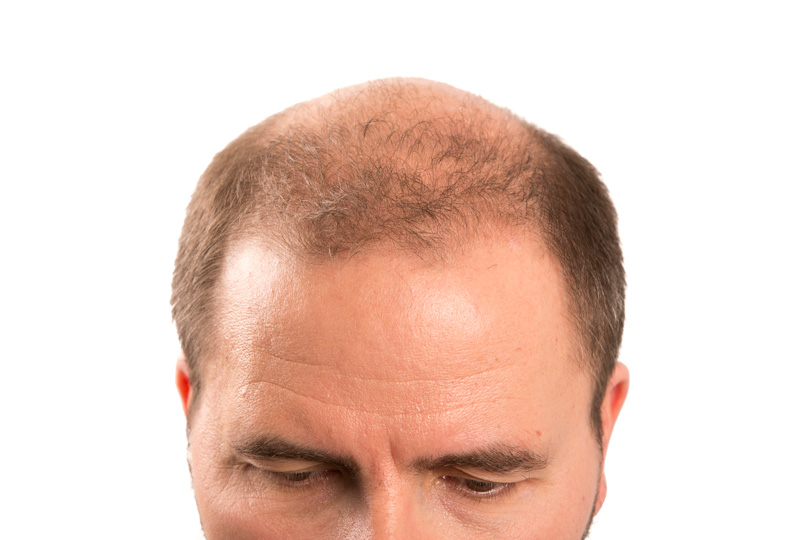
10
Jul
Treating Hair Loss With Minoxidil

Minoxidil is a topical treatment that is commonly used to slow down male pattern hair loss (androgenetic alopecia) and can even help regrow hair. It can be purchased over the counter as a liquid or foam in two strengths (2% and 5%) and is commonly sold under the brand name Rogaine. Patients who use Minoxidil can see results within several months.
Does Minoxidil Actually Work As A Treatment For Hair Loss?
Yes. Minoxidil has been shown to prevent hair loss in 2 out of 3 men and is currently the only treatment approved by the FDA. Minoxidil’s primary function is to prevent and slow down hair loss; hair regrowth is more of a side effect.
Minoxidil cannot create new hair follicles, so it cannot be used to grow hair that has already been lost. Because of this, Minoxidil will be most useful when the hair loss is caught early on so that it can prevent and slow down future loss.
One study showed that 5% Minoxidil was more effective at preventing hair loss and encouraged hair growth 45% more than its 2% solution counterpart. In addition, the 5% Minoxidil was superior in achieving hair growth both earlier and faster (Olsen).
How long will it take to see results?
Minoxidil is proven to work, but noticeable results require patience. Many people start to see less hair loss and some new growth in 4 to 6 months. For best results, this medication must be applied twice daily. Since discontinuing Minoxidil will stop the progress of the treatment, it is most effective when used as part of a daily routine.
How Does Minoxidil Work?
In order to understand how Minoxidil works, it is helpful to understand how normal hair growth works. Hair goes through a three-phase cycle: Anagen, Catagen, and Telogen.
- The first phase, the anagen phase, is the phase where the hair follicle receives a blood supply and is actively growing. In this phase, the cells in the root of the hair are rapidly dividing and are pushed upwards. On average, hair grows about half an inch every 28 days. Depending on your age, this may be faster or slower. The anagen phase lasts about 3-6 years before the catagen phase is triggered.
- The next phase, the catagen phase, is a transition stage that occurs right after the anagen phase. During this transition time, hair follicles are cut off from their blood supply and hair growth ceases. At this point, the hair follicle is pushed upwards to make room for the next hair to grow beneath it. After the hair is pushed, upwards the hair enters the telogen phase and becomes what is known as a ‘club hair’.
- In the telogen phase, the club hair rests and stays in place as another hair in the anagen phase grows beneath it. The hair remains in place until it is pushed outwards by the incoming hair from the anagen phase, restarting the cycle. Each hair follicle is independent from one another and are in different phases at different times so that all of the hair follicles won’t fall out at once. In individuals with androgenetic alopecia, each anagen phase gets shorter while the telogen phase gets longer, meaning the hair follicle will spend more time resting rather than growing.
Minoxidil is a vasodilator. This means that when applied, Minoxidil increases the blood flow to the hair follicles. The increased blood flow to the hair follicles stimulates them from their resting telogen phase into their growth anagen phase. Additionally, Minoxidil extends the anagen phase itself, meaning that hair spends more time growing. Increasing blood flow also increases the diameter of the follicles, leading to thicker hair.
Skin Quiz
We worked closely with experts to create a skin quiz that guides you to the best treatments on the market.
Get at Home TreatmentAre there any side effects?
Overall, Minoxidil is a very safe topical treatment. Like any drug, there are some possible side effects, although these are uncommon.
Side effects occur at the application site and may include:
- Itchiness
- Skin rashes
- Flaky skin
Most of the time, these side effects are temporary and resolve on their own. If side effects persist, you should stop using Minoxidil and contact your dermatologist.
Can it make hair loss worse?
During the first several weeks of treatment, some people may notice that their hair loss seems to be getting worse. However, this is just a sign that the treatment is working since Minoxidil speeds up the telogen cycle. In other words, the hair that initially sheds is actually the hair that was already in the process of shedding.
The new growth that emerges will be both thicker and healthier. Minoxidil will then extend the growth cycle (the anagen phase) of the new hair that emerges, causing a decrease in overall hair loss.
Does Minoxidil only work on men?
No. Minoxidil can be used to treat both male pattern baldness and female pattern baldness. Minoxidil’s main focus was originally to treat male pattern baldness, but because of its effectiveness, it was later researched and extended to treat female pattern baldness as well. For women, the recommended treatments are to either apply the 2% liquid twice a day or to apply the 5% foam once a day.
References
- Cafasso J. Does Rogaine Work? On Thin Hair, Beards, Women, or Receding Hairline. Healthline. https://www.healthline.com/health/does-rogaine-work. Published August 7, 2024.
- Olsen EA, Dunlap FE, Funicella T, et al. A randomized clinical trial of 5% topical minoxidil versus 2% topical minoxidil and placebo in the treatment of androgenetic alopecia in men. J Am Acad Dermatol. 2002;47(3):377-385. doi:10.1067/mjd.2002.124088. https://pubmed.ncbi.nlm.nih.gov/12196747/.

